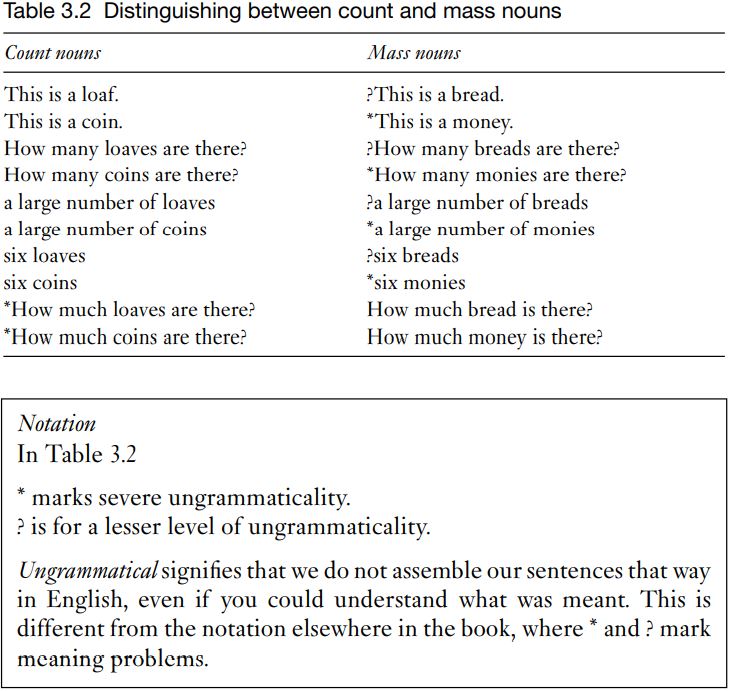

Grammar


Tenses


Present

Present Simple

Present Continuous

Present Perfect

Present Perfect Continuous


Past

Past Simple

Past Continuous

Past Perfect

Past Perfect Continuous


Future

Future Simple

Future Continuous

Future Perfect

Future Perfect Continuous


Parts Of Speech


Nouns

Countable and uncountable nouns

Verbal nouns

Singular and Plural nouns

Proper nouns

Nouns gender

Nouns definition

Concrete nouns

Abstract nouns

Common nouns

Collective nouns

Definition Of Nouns

Animate and Inanimate nouns

Nouns


Verbs

Stative and dynamic verbs

Finite and nonfinite verbs

To be verbs

Transitive and intransitive verbs

Auxiliary verbs

Modal verbs

Regular and irregular verbs

Action verbs

Verbs


Adverbs

Relative adverbs

Interrogative adverbs

Adverbs of time

Adverbs of place

Adverbs of reason

Adverbs of quantity

Adverbs of manner

Adverbs of frequency

Adverbs of affirmation

Adverbs


Adjectives

Quantitative adjective

Proper adjective

Possessive adjective

Numeral adjective

Interrogative adjective

Distributive adjective

Descriptive adjective

Demonstrative adjective


Pronouns

Subject pronoun

Relative pronoun

Reflexive pronoun

Reciprocal pronoun

Possessive pronoun

Personal pronoun

Interrogative pronoun

Indefinite pronoun

Emphatic pronoun

Distributive pronoun

Demonstrative pronoun

Pronouns


Pre Position


Preposition by function

Time preposition

Reason preposition

Possession preposition

Place preposition

Phrases preposition

Origin preposition

Measure preposition

Direction preposition

Contrast preposition

Agent preposition


Preposition by construction

Simple preposition

Phrase preposition

Double preposition

Compound preposition

prepositions


Conjunctions

Subordinating conjunction

Correlative conjunction

Coordinating conjunction

Conjunctive adverbs

conjunctions


Interjections

Express calling interjection

Phrases

Sentences


Grammar Rules

Passive and Active

Preference

Requests and offers

wishes

Be used to

Some and any

Could have done

Describing people

Giving advices

Possession

Comparative and superlative

Giving Reason

Making Suggestions

Apologizing

Forming questions

Since and for

Directions

Obligation

Adverbials

invitation

Articles

Imaginary condition

Zero conditional

First conditional

Second conditional

Third conditional

Reported speech

Demonstratives

Determiners


Linguistics

Phonetics

Phonology

Linguistics fields

Syntax

Morphology

Semantics

pragmatics

History

Writing

Grammar

Phonetics and Phonology

Semiotics


Reading Comprehension

Elementary

Intermediate

Advanced


Teaching Methods

Teaching Strategies

Assessment
Count nouns and mass nouns
المؤلف:
Patrick Griffiths
المصدر:
An Introduction to English Semantics And Pragmatics
الجزء والصفحة:
55-3
12-2-2022
1902
Count nouns and mass nouns
In the grammar of English, there is a clear distinction between count nouns, exemplified by loaf and coin in Table 3.2, and mass nouns, exemplified by bread and money. The whole noun vocabulary divides into words that are almost always count nouns (garment for instance), ones that are almost always mass nouns (like clothing) and ambiguous ones which can be used as either mass or count nouns (like cake).
The question marks in Table 3.2 are there because of a special use allowable with some mass nouns, as when bread is taken to denote ‘distinct variety of bread’. For example, one might say of a bakery that it produces “six breads” to mean that it produces ‘six types of bread’: wholewheat, focaccio, French sticks, and so on. Six breads is ungrammatical for attempting to express the meaning ‘six loaves’.

Mass nouns resist being quantified with numbers and plural suffixes or the word many or the singular indefinite article a (right-hand column in Table 3.2), while count nouns (in the left-hand column) can be quantified in this way. Count nouns denote distinguishable whole entities, like beans or people or shirts. They can be counted. Mass nouns are quantified with the word much. They denote undifferentiated substance, like dough or water or lava.
Table 3.2 shows that the difference between count nouns and mass nouns is partly a matter of how the speaker or writer chooses to portray reality. What is out there in the world is pretty much the same whether you are referring to a loaf or to bread; likewise, the denotation of the words coins (and banknotes or bills) is pretty much the same as that of the word money. However, count nouns portray what we are talking about as consisting of individually distinct wholes (loaves, coins, banknotes, bills and so on), while talking about almost the same reality with mass nouns represents it as homogeneous substance, undifferentiated “stuff ”. Another pair that could have been selected to illustrate this is drinks (count) and booze (mass).
It is certainly not the case that when people use mass nouns to talk or write about clothing or bread or money or scenery, that they become incapable of distinguishing shirts from socks, or one sock from another, or seeing boundaries between the lakes, mountains and seascapes that go to make up scenery. They are merely treating scenery or money or what-ever as if “how much” were the only difference there could be between one “dollop” of the stuff and any other dollop of it.
Hyponymy and incompatibility have been illustrated almost entirely with count nouns. However, these two relations exist among mass nouns too. Velvet ‘cloth with a silky nap’, corduroy ‘cloth with a corrugated nap’, gingham and so on are mass nouns that are incompatible hyponyms of the mass noun cloth. (The mass noun cloth is the one seen in How much cloth is produced annually? There is a count noun cloth too, for instance in You’ll never use all these old cloths for wiping oil off your bicycle; throw some of them away.)
Only individuated wholes are represented in English as having parts. Homogenous substance is not separable into distinct parts. Therefore, only count nouns bear has-relations to labels for their parts; mass nouns do not enter the has-relation (except in physical chemistry, but that is another story).
 الاكثر قراءة في Semantics
الاكثر قراءة في Semantics
 اخر الاخبار
اخر الاخبار
اخبار العتبة العباسية المقدسة

الآخبار الصحية















 قسم الشؤون الفكرية يصدر كتاباً يوثق تاريخ السدانة في العتبة العباسية المقدسة
قسم الشؤون الفكرية يصدر كتاباً يوثق تاريخ السدانة في العتبة العباسية المقدسة "المهمة".. إصدار قصصي يوثّق القصص الفائزة في مسابقة فتوى الدفاع المقدسة للقصة القصيرة
"المهمة".. إصدار قصصي يوثّق القصص الفائزة في مسابقة فتوى الدفاع المقدسة للقصة القصيرة (نوافذ).. إصدار أدبي يوثق القصص الفائزة في مسابقة الإمام العسكري (عليه السلام)
(نوافذ).. إصدار أدبي يوثق القصص الفائزة في مسابقة الإمام العسكري (عليه السلام)


















